American White Pelicans are known for their conspicuous black and white coloration, cooperative foraging techniques and large body size. But what I enjoy most about them is the contrast between the goofy, almost comical proportions of their huge bill and pouch and their graceful, choreographed flight patterns when flying in flocks.
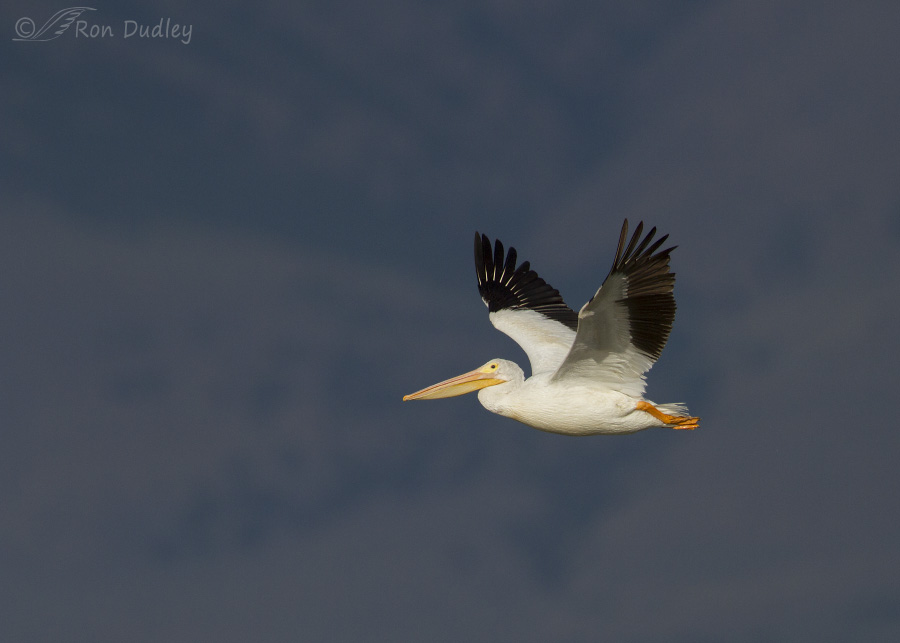
1/5000, f/6.3, ISO 500, Canon 7D, Canon EF 500mm f/4L IS II USM + 1.4 tc, not baited, set up or called in
Three days ago at Bear River MBR I photographed this pelican in somewhat unusual lighting conditions. The mostly bright white bird was lit up by the morning sun but the Promontory Mountains in the background were in deep shade. The bird is small in the frame but in this case I like it that way because it allows for more of those moody, dark mountains in the background. In this light and with this dark background the pelican seemed to positively glow, almost like it was fluorescent. Literally.
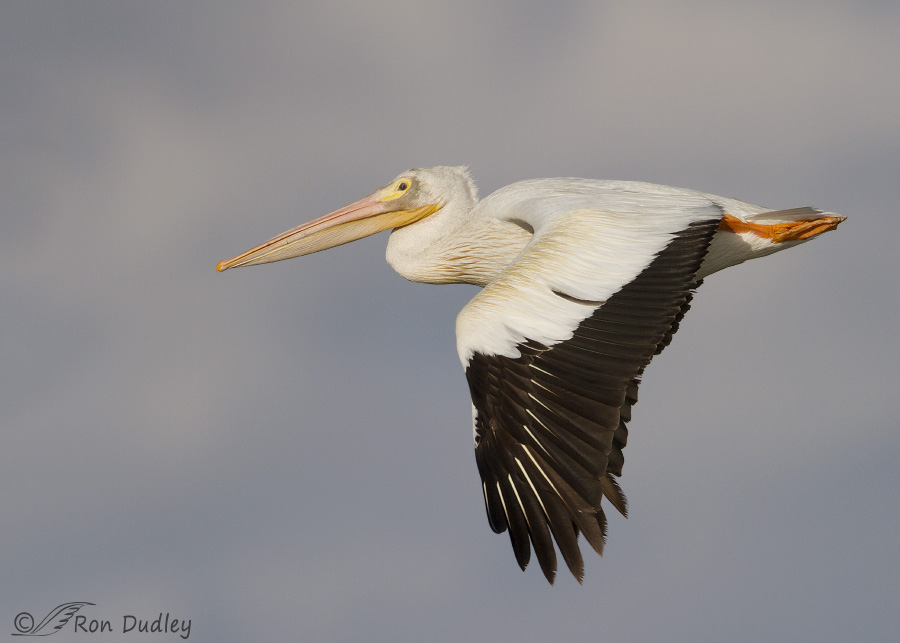
1/5000, f/6.3, ISO 500, Canon 7D, Canon EF 500mm f/4L IS II USM + 1.4 tc, canvas added for composition, not baited, set up or called in
But I was also able to get some frame-filling shots of pelicans in flight that morning. In these two sequential images I got wings down…
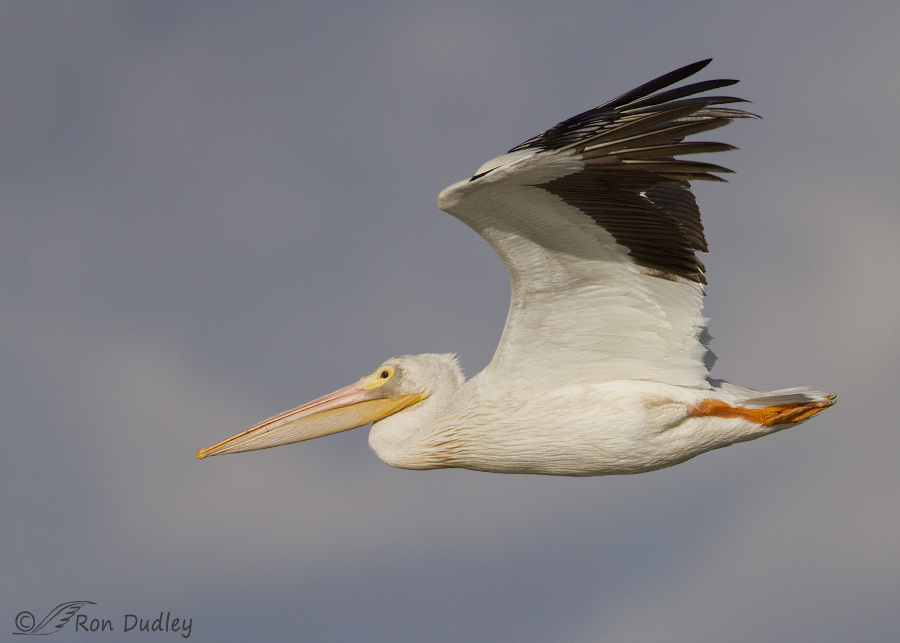
1/5000, f/6.3, ISO 500, Canon 7D, Canon EF 500mm f/4L IS II USM + 1.4 tc, canvas added for composition, not baited, set up or called in
and wings up.
When I was a kid growing up on Montana in the 50’s and early 60’s I never saw pelicans. By then human disturbance, changing water levels and contaminants had reduced their numbers to threatened status. But since the early 60’s their numbers have rebounded and these days I see significant numbers of pelicans every time I return to my Montana stomping grounds – especially along the Missouri River but elsewhere too.
And huge numbers of pelicans breed on islands in the Great Salt Lake near where I now live. American White Pelicans are a real (and rare) avian success story and their numbers continue to increase at greater than 3%/year, to the point that they have created conflicts with the aquaculture industry in the Southeastern U. S, especially during spring migration.
Ok, a change of pace to end this post.
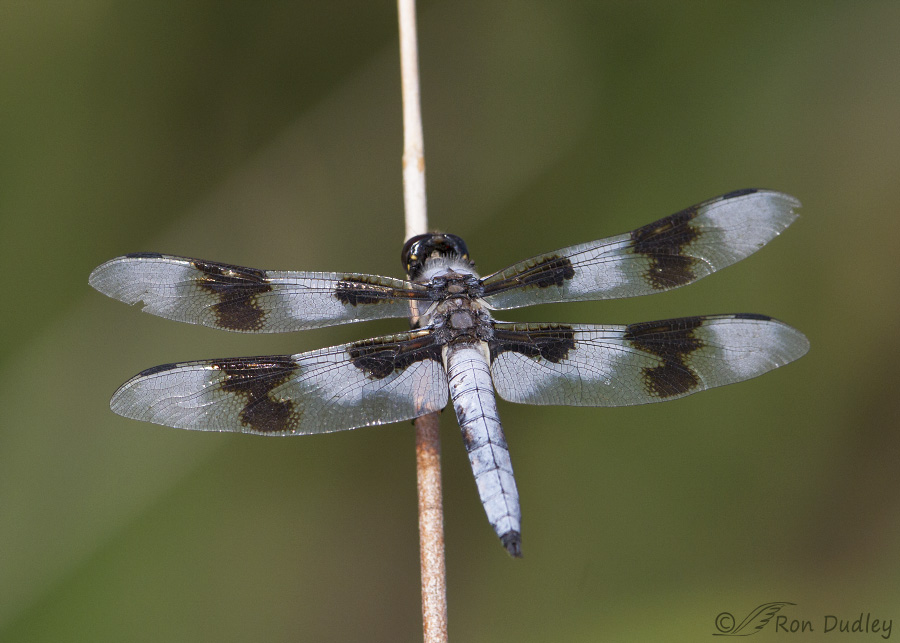
1/3200, f/6.3, ISO 640, Canon 7D, Canon EF 500mm f/4L IS II USM + 1.4 tc
Yesterday on my way home from Antelope Island I stopped by Farmington Bay WMA just to check out the bird situation. Birds were slow but I photographed a couple of other interesting subjects on Glover Pond including this beautiful dragonfly seeking shelter from the wind in a protected area of cattails.
Dragonflies are classified in suborder Anisoptera of order Odonata. Anisoptera means “uneven wing” which refers to the fact that in dragonflies the hindwings are broader (wider) than the forewings and that characteristic is clearly demonstrated here. I always find little factoids like that interesting.
Does anyone know what species this is? I haven’t a clue…
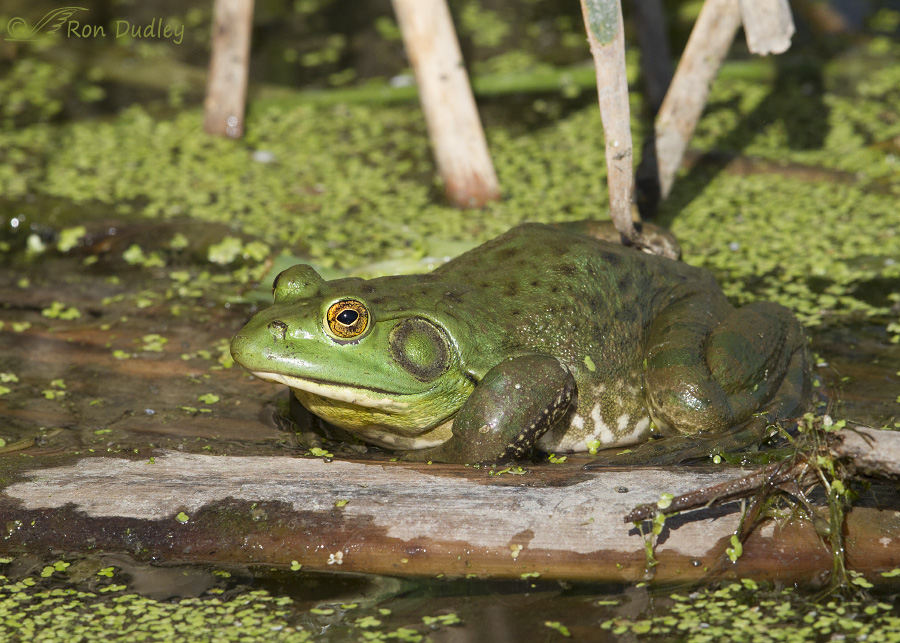
1/1250, f/9, ISO 640, Canon 7D, Canon EF 500mm f/4L IS II USM + 1.4 tc
And Kermit was just below where the dragonfly was perched. Whenever I get a good, detailed look at a frog I’m always fascinated by their interesting eyes and tympanic membranes so I couldn’t resist including this photo.
Ron
Note: Photographers will likely wonder what the heck I was thinking to be using such high shutter speeds for most of these shots. Lighting was so variable that morning that I was missing shots when I took the time to choose appropriate camera settings for the situation so in the end I just stopped worrying about it very much and fired away. That’s my story and I’m sticking to it.


Apart from the difference in size, males and females look exactly alike. Immature birds have light grey plumage with darker brownish nape and remiges. Their bare parts are dull grey. Chicks are naked at first, then grow white down feathers all over, before moulting to the immature plumage. Both parents incubate for about to one month. The young leave the nest 3–4 weeks after hatching; at this point, usually only one young per nest has survived. They spend the following month in a creche or “pod”, moulting into immature plumage and eventually learning to fly. After fledging , the parents care for their offspring some three more weeks, until the close family bond separates in late summer or early fall, and the birds gather in larger groups on rich feeding grounds in preparation for the migration to the winter quarters. They migrate south by September or October.
It’s pretty well all been said above but I have to add how much I enjoy all your photos and information. I love the first Pelican shot and you are right, the size is great. Any larger and the brilliance would blind us! Ha! I have a collection of insect and frog images but no 8 Spotted.
Pelicans? Dragonflies? Frogs?
HAPPY DANCES FROM HERE.
Big, wobbly, delighted happy dances.
“Pelicans? Dragonflies? Frogs?”
Yep, that’s quite a combination from me, isn’t it, EC. Thank you.
These images are great! I don’t see many around MN, though I think their migration brings them through. When I am visiting the west coast I love watching groups of these birds cruising the air currents along the shore. They remind me of a squadron of old cargo planes!
Thank you, Deb. Agree with your comparison to a squadron of large, slow planes.
I live close to dowtown Salt Lake and in the spring and early summer the pelicans come to fish in the pond at Forest Dale golf course. I love the way they soar when in flight. Beautiful birds and fun to watch when they are ganging up on the carp in the lake.
They do the same thing at a pond near my home, Betty. Always fun to watch.
WOW, Great Shots, Ron.
Didn’t read all the posts, so someone else may have come up with the dragonflies name, but the dragonfly is an Eight-spotted Skimmer, Libellula forensis, male. And, nice shot of an American Bullfrog!
Thank you, Dick. You, Mia and Susan all agree on the dragonfly ID.
I loved the dragonfly shot—-I’m hoping that you find many more beautiful insects–I’d welcome seeing them in your blog !
I’ll keep that in mind, Kris. I agree, I should photograph them more often.
My favorite cane is topped with a life-sized painted carved wooden frog’s head…It.looks like I’m holding a real one in my hand. Children, most men and some women love it…so do I! It gets beaten up and just I give it new wood putty eye bump and an acrylic touch up. It’s a very political frog. Its shaft is covered with statement stickers. Fortunately for me, we share the same ploitical views. Sometimes people ask to take pictures of and with it…So far, no one as asked it for an autograph. I got it in a general store in Maine, called Hussey’s. Outside is a tall pylon sign that says, ” SHOT GUNS, WEDDING GOWNS, COLD BEER”. I also have a dragonfly doorknocker. You done good by me!
You’re a hoot, Patty!
These images were a real treat for me as I love frogs and dragonflies as well as white pelicans. Frogs’ 24 carat golden eyes are so beautiful, their expressions so benign. I played with them for hours as a kid. They loved to have their nacks stroked gentlely with a stalk of grass. I’ve always love dragonflies and damselflies, finding something magical about both of them. A couple of years ago, I had an amazing encounter with a huge dragonfly as it searched for a way out of the house. I finally caught it and released it. watching it weigh options is something I’ll never forget. Supposedly, helicopters were inspired by dragonflies…the resemblance is pretty obvious
“24 carat golden eyes”
Perfect description of those eyes, Patty.
Good shots of the Pelicans – I never saw them here in MT as a kid either and there are plenty around now! Watching a flock in flight cruising slow in formation is always a treat. Love the dragon fly and frog – nice sharp shots of both. The dragon flies can be hard to get unless found in the circumstances you did or early morning when it’s cool and they’re trying to warm up. 🙂
Thanks for backing up my memory about the lack of pelicans in Montana back then, Judy. After this many years I was hoping that my memory hadn’t failed me.
Nice Pelicans Ron. Do like the background on the first one. We have been up in Alder, Mt.for the last month and there is a nice group of them on the Ruby Reservoir. I like to get in my inflatable and go out on the inlet where, as the lake drops due to irrigation requirements, the mud flats are exposed where the Pelicans aggregate. They have not been very cooperative this year so I have not gotten many preening birds, but lots of avocets and other peeps. I did get a good flight shot yesterday when I spooked one off the water.
Story on the pelicans. We were exploring over at the Clark Canyon Reservoir and happened upon Fish and Game stocking the lake with trout. The guy working for Montana estimated that he dumped close to 275,000. The pelicans were waiting, as were the gulls, for the gentlemen to leave. Upon his exit, here came a group of some 12 birds. I watch and photographed the group basically herd the fish in a u shaped patter and then all dipped their heads at once. Interesting feeding behavior. I watched for about 30 minutes and the pelicans were still at it. Interesting, the gentleman from Fish and Game said there are now doing a lot of stocking at night to hopefully get a better survival rate on the young trout. No wonder the fishermen up here don’t have a lot of good things to say about the rebound on the pelican population, but what the hey!
Thanks again for the post. Enjoy it every morning. Keep up the streak.
Interesting story about the pelicans and the stocked fish, Frank.
I see that cooperative feeding behavior in groups of them often. It’s so choreographed that it can be mesmerizing to watch.
There’s just something special when these large birds do the flock thing–just magical.
Magical for sure, Laura. A flock of many dozens of them stand out so very well for a few moments but then when the group turns in unison to a different angle they actually disappear from sight and you wonder what in the world happened to them…
Ron, your dragonfly is an Eight-spooted Skimmer (Libellula forensis). It was actually easy for me to figure it out (and I am no Dragonfly expert) because I had previously identified a Twelve-spotted Skimmer at Hueco Tanks… The lesson about Dragonfly wings was very interesting. And I love the first photo of the Pelican. The dark background is perfect, and the bird doesn’t need to be any larger in frame than it is. We are enjoying seeing Brown Pelicans fly overhead while we’re at the beach.
Susan, thanks to you (and to Mia) for the ID.
I’m glad you like that first shot. I wasn’t sure how much appeal it might have.
The dragonfly is a male Eight-spotted Skimmer (Libellula forensis).
Thank you, Mia.
Hi Ron
Amazing as always. The detail in the whites are amazing. Crispy flight shots.
Thanks for sharing.
Thanks for noticing the exposure on the whites, Nikhil – they’re always a challenge as you well know.
Sensational series Ron!
Charlotte Norton
Thank you, Charlotte.